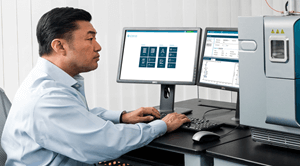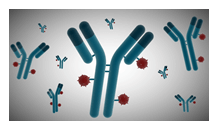Are you thinking about replacing existing immunoassay technology with clinical mass spectrometry? Keep reading to discover how the 3 “S”s will help you make the decision. 1. How does sensitivity play a role? Many of the analytes measured in a clinical chemistry lab...
Tags
Overcoming uncertainty in your PFAS analysis
Just like gum on the bottom of a shoe, the existence of per- and poly-fluorinated alkyl substances (PFAS) in our environment is a sticky one. If you’re in the field of environmental testing, then you’re all too familiar with the threat these substances have on public health. While we have learned a lot about them over the years, there is still much more to understand. With the right detection methods, we can gather the information we need to empower us to make informed decisions on reducing the risks they impose.

6 Signs it’s time for a new vendor
A lab’s success depends on many factors from instrument quality to efficient operations, including being partnered with the right vendor. A vendor is more than just a supplier. They should provide you with a high-level quality of support in maximizing the lifespan and performance of your systems, reducing downtime, enhancing ROI and more. How do you know if you’re partnered with the right one? Here are six signs it might be time to find someone new.

Selecting an LC-MS system for quantitation of pharmaceutical drug development
We understand you are busy, needing to prioritize running instruments, reporting results and managing your laboratory to meet deadlines. We created a solution guide to explain how SCIEX systems fit in the drug development pipeline to save you time evaluating options.

Nitrosamines: Where are we now?
Nitrosamines are a large group of N-nitroso compounds that share a common functional N-N=O group. They are produced by a chemical reaction between a nitrosating agent and a secondary or tertiary amine. Back in 2018, nitrosamines suddenly found themselves in the spotlight when they were unexpectedly detected in medications for high blood pressure. Since then, they have been found in several other prescription medications, including those for heartburn, acid reflux and diabetes, resulting in manufacturers recalling some common medications.

Celebrating customer experience: Insights from SCIEX leaders
Introduction Customer Experience Day (CX Day) is a special occasion for SCIEX, celebrated every first Tuesday in October. It’s a day dedicated to recognizing the incredible value of our customers and the relentless dedication of our associates who strive to make...

PFAS analysis in food: a robustness study in sensitivity and stability
The combination of per- and polyfluoroalkyl substances (PFAS) testing, trace-level regulatory requirements and complex MS applications can be intimidating. In a recent webinar, now available on demand, SCIEX PFAS expert Craig Butt demonstrated how the new SCIEX 7500+ system can help make PFAS testing easier.

Your success and voice go a long way!
At the heart of everything we do is ensuring that your workflows and team are empowered to achieve optimal results with your SCIEX instruments, software, consumables, and services. Every interaction with SCIEX is designed to support your success through the dedication...

FDA’s final rule on LDTs: what does it mean for clinical laboratories?
On April 29, 2024, the U.S. Food and Drug Administration (FDA) announced a final rule regulating laboratory developed tests (LDTs) as in vitro diagnostic devices (IVDs) under the Federal Food, Drug and Cosmetic Act (FD&C Act). This rule amends FDA’s regulations to state that in vitro diagnostic tests “manufactured” by clinical laboratories fall within the scope of the FDA regulatory oversight and is poised to dramatically shift the way clinical diagnostic laboratories in the United States develop and offer LDTs in the future. Read this blog post for a basic overview of the scope, intent and implications of this final rule, including the regulatory requirements, exceptions and timeline for implementation.

LC-MS system replacement: Are you ready?
Meeting deadlines in a bioanalysis laboratory can be a big challenge. Older, less sensitive and less reliable LC-MS systems make it even more difficult. Even the disruption caused by the installation and validation can be disconcerting and delay decisions. Does this sound familiar?

An overview: LC-MS analysis of targeted protein degraders and their metabolites
Targeted protein degraders (TPD) are a relatively new therapeutic modality that opens the potential to target disease-causing proteins. These disease-causing proteins have been highly challenging for traditional small-molecule therapeutics to treat, making TPDs an exciting new therapeutic modality.

Say Goodbye to MetID Headaches, Say Hello to Automated Large Molecule Catabolism Processing
Is your mind swimming with large molecule catabolism data? Do you spend hours manually processing through complex spreadsheets to match your data with theoretical biologic catabolites? Are you wasting precious time by drawing out and processing your therapeutic peptide as a small molecule? Are you worried that you could be missing something?

Using the X500R QTOF System and SCIEX OS to Identify and Quantify Food Residues
Farmers use pesticides to protect crops from insects and disease as pesticides are necessary to create the volume of food that our population requires. Without them, we would not be able to grow enough crops to feed the world—they are a necessary evil. Government agencies such the Food and Drug Administration (FDA) in the United States and pesticide manufacturers, however, work hard to educate farmers on how to minimize their use. However, sometimes farmers add too much which leaves a residue. Upon harvest, farmers wash the fruit and vegetables. Once complete the crop then makes its way to the wholesaler and eventually, the supermarket. Even so, there may still be pesticide residue on the produce, which is why government agencies randomly pull produce from store shelves for testing of maximum residual limits (MRLs) and we are encouraged to wash our food before consuming it

The World Has its Eyes on Precision Medicine
What if we could understand and then treat diseases on an individualized level, in a way that was tuned to a person’s individual biology? Not in a futuristic, ‘wave a high-tech scanner across a person’s body’ way, but in a legitimate ’I can run a lab test and know the best action to take’ way. This is the promise of Precision Medicine, to deliver the right treatment to the right patient, at the right time, predicting more accurately which treatments will work for certain groups of patients, in contrast to the pervasive one-size-fits-all approach. More specifically, if we could provide a comprehensive report at the molecular level of an individual (based on genome, proteome, or metabolome profiles), a physician could be much better informed to make optimal treatment decisions. And if we could track these profiles over time, a person could adjust their lifestyle to focus on long-term wellness.

Setting Records with Fast Glycan Technology
There is a lot of talk going around in the lab, and it has to do with the newly released Fast Glycan Labeling and Analysis technology. Where once research analysts needed to set aside days to perform glycan analysis, now takes an hour or so. Glycans are immediately identified by the software – so no need for data interpretation. That’s up to 5x faster than HILIC.

Confidently Screen For Your Usual Suspects—Plus Those That May Be Lurking Within Your Food Sample
The demand on labs throughout the world to run their triple quadrupole mass spectrometers to maximum capacity is ever increasing. Instruments are often operated continuously to ensure regulatory screening requirements are satisfied for targeted pesticides, mycotoxins, and veterinary drugs. Whether you are a commercial lab or a food manufacturer, the quality of the data you acquire is vital to your business. You must be certain that the last batch of strawberries you tested conform to pesticides regulations—your targeted list of usual suspects.

Turning up the Speed on Forensic Toxicology Screening and Quantitation
Working in a forensic lab means technicians want super high-quality data in ultra-fast time. Yet, how do you go about detecting an unlimited number of analytes without re-injecting the sample all while new targeted compounds are being added to the screened panel? In the following application note, “Ultra-Fast Forensic Toxicological Screening and Quantitation in Under 3 Minutes Using SCIEX X500R QTOF System and SCIEX OS 1.0 Software,” researchers set out to achieve a fast method that could detect an unlimited number of analytes with all information afforded mass accuracy, LC retention time, and MS/MS spectral library matching.

What Food Safety Trends are Coming This Year?
As we settle into 2017, I can’t help but reflect on the previous year’s food safety. Take for example the legislative changes meant to contain contamination outbreaks like those happening in places like China, Singapore, and New Zealand. Over the past year, we have developed new methods that detect antibiotics in poultry feed, LC-MS/MS Analysis of Emerging Contaminants, and help set food standards in China. All the while developing more sophisticated technology to keep up with testing demands.

Never Stop Learning with SCIEX University
Did you know that when you log into SCIEXUniversity, you have 24/7 access to educational tools? Simply click on the Support from SCIEX.com and select SCIEXUniversity. Here you will find more than 100 newly revamped courses developed by in-house experts, scientists, and researchers who, just like you, are interested in the next scientific breakthrough. Whether you are a beginner mass spec user or have years of experience, these online and on-site courses are designed with you, the user, in mind. What is more is that the course catalog offers self-paced training and certification programs to help you get better acquainted with software, instrumentation, and workflows

Fast and Simultaneous Analysis of Ethanol Metabolites and Barbiturates
While most analytes in forensic applications analyze well with positive ionization, there are analytes that show better ionization efficiency with negative ionization, for example, acidic compounds. These analytes include ethanol metabolites such as ethyl glucuronide (ETG), ethyl sulfate (ETS), and the barbiturates such as amobarbital, butabarbital, butalbital, pentobarbital, phenobarbital, and secobarbital.

It’s a Point and Click World with the X500B QTOF System for Biologics Characterization
Did you know the X500B QTOF system makes point and click workflows for Biologics Characterization possible on your mass spectrometer? The newly-designed SCIEX OS software interface brings to life fluid navigation and ease of use so you can keep moving forward on your scientific discoveries. In fact, it’s so simple to learn and operate that you and your team can be up and running faster than you might expect.

PPCP Detection in Drinkwater is no Match for the QTRAP® 5500
SCIEX is no stranger to drinking water analysis, and the Environmental Compendium once again addresses the topic in an application note which covers LC-MS/MS with Fast Polarity Switching. Using the QTRAP® 5500, researchers were able to detect a large panel of Pharmaceuticals and Personal Care Products (PPCP’s) while performing fast positive/negative switching all from a single injection. Method details go the distance in this application note, as five experiments were called into action for comparison.

From Extraction to Cleanup—Measuring Mycotoxins from Cornmeal Products
When we look at emerging food trends for this coming year, you may be surprised to find that the US cornmeal market is making headlines as it is set to grow at a compound annual growth rate (CAGR) of two percent by 20201. This is the type of news that excites us, scientists, as it reminds us why we test for things like mycotoxins in cornmeal and the impact such analysis has on farmers and food manufacturers.

See How Easy It Can Be to Get Expert Results for Biologics Characterization
Learning a new mass spec system can be a daunting task. Aside from the opportunity costs of training new users, you might face the hassle of downtime, and the wait to get expert help when needed. The X500B QTOF system puts a new spin on biologics characterization workflows because it is so easy to learn and operate that you can be up and running much faster than you expect. Powerful new software tools dramatically streamline method development and data processing, to enable everyone in your lab to get expert results. It’s fast because it’s easy, even for new users.

Getting a Clean Match in Forensic Toxicology using LC-MS/MS
As a forensic scientist, what holds you back in the lab? It’s a question we often ask ourselves here at SCIEX, as product development depends on customer wants, needs, satisfaction, and ease of workflow. Ensuring evidence can withstand forensic scrutiny, for example, correlates with the integrity of testing procedures. Knowing this, how do you convince your staff to be confident in results, or convey technical data to a non-technical courtroom audience? If you have been left wondering how to get to the bottom of topics like these, check out the following toxicology toolkit. It’s a bundle of resources at your fingertips that includes a webinar led by Tania A. Saski Ph.D., Northwest Physician Laboratories, Bellevue, Using QTRAP® Technology to Provide Accurate Identification and Confirmation Beyond a Reasonable Doubt, and so much more

Looking to Quantify and Identify Pesticides in your Food Samples?
Visit our offices on any given day, and you are likely to discover researchers putting mass spectrometry to the test. The hum of the mass spectrometer is as common as conversations as scientists are tasked with developing methods that can be applied in real-world lab scenarios. In this case, André Schreiber SCIEX, Concord, Ontario, Canada, detailed, Comprehensive Quantitation and Identification of Pesticides in Food Samples Using the SCIEX UltraLC 100* and the SCIEX QTRAP® 4500 System.

Discover the New X500B QTOF System, the Simpler, Faster Path to Biologics Characterization Answers
Have you ever wished for a compact instrument that delivers expert-level answers to your most complex biotherapeutic characterization challenges faster and easier than what you are doing now? At SCIEX, we recognize that even expert users want easier ways to perform daily characterization tasks and get great results every time. That’s why we set out to develop the X500B QTOF system: a robust and reliable new instrument and software solution that reduces complexity and simplifies biologics characterization workflows so every scientist can get expert-level results

How to Achieve Higher Sensitivity with Hybrid Immunoaffinity LC-MS Assays
Protein-based biotherapeutics, including monoclonal antibodies (mAbs) and antibody-drug conjugates (ADCs) are a growing component of pharmaceutical companies’ drug pipelines. The growth of ADCs in particular is due to their ability to selectivity target and deliver a potent molecule to a cancer cell based on a specific tumor marker. In order to support this growing class of new drug molecules, robust and reliable bioanalytical methods are required. While ligand binding assays (LBAs) like ELISA have been the most popular platform for biotherapeutic quantitation, bioanalytical scientists have been increasingly adopting hybrid LBA/LC-MS methods in this area.

The Application of Research Grade MetabolitePilot™ Software for the Determination of the Catabolic Peptide Products of Exenatide
The stability of peptide and protein biotherapeutics directly impacts their pharmacokinetic profile, efficacy, and safety. It is therefore essential to characterize the stability of a given bio-therapeutic including both in-vivo and in-vitro catabolism, thereby...

LC-MS/MS Screening of 64 New Psychoactive Substances Using Dried Blood Spots
There is a lot you can tell from a droplet of blood as it’s snapshot of what could be present in a body at any given moment. In the following application note, LC-MS/MS Screening of 64 New Psychoactive Substances Using Dried Blood Spots, researchers did just...

LC-MS/MS Analysis of Emerging Food Contaminants
Ever wish you had access to the most up to date application methods but don’t know where to find them? The Food and Beverage Compendium is your one-stop resource for research notes ranging from pesticides, allergens, and antibiotics to mycotoxins, vitamins, and...